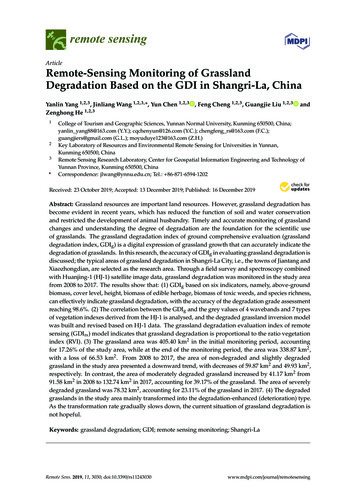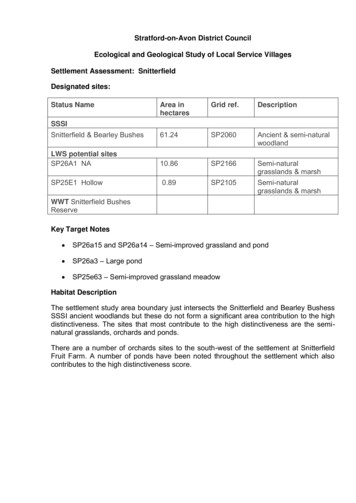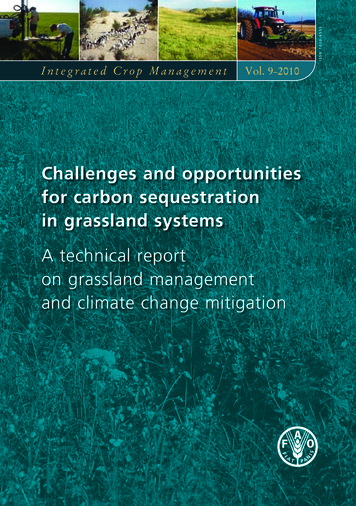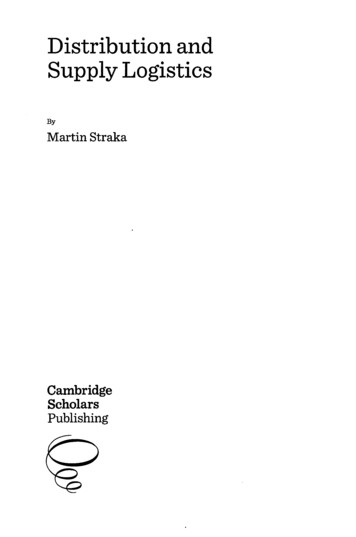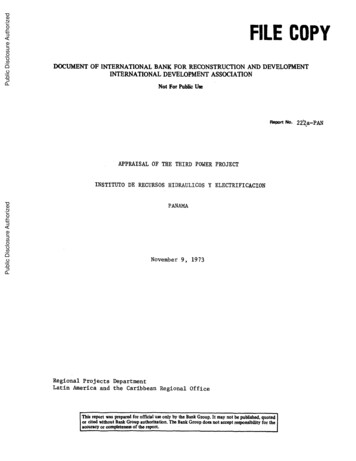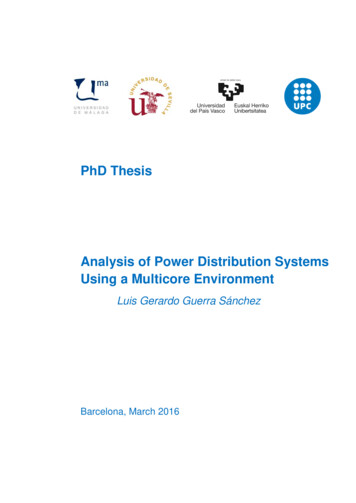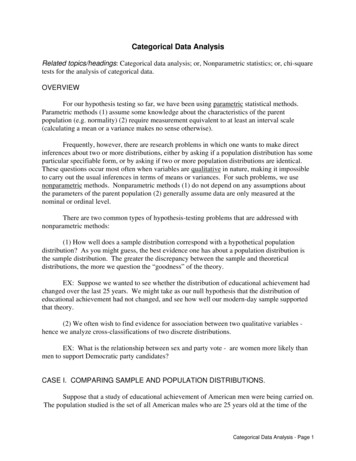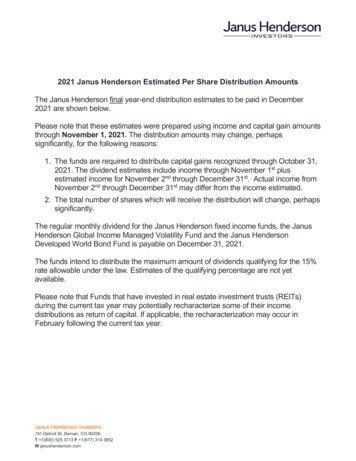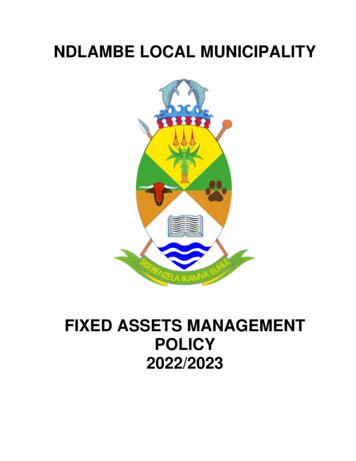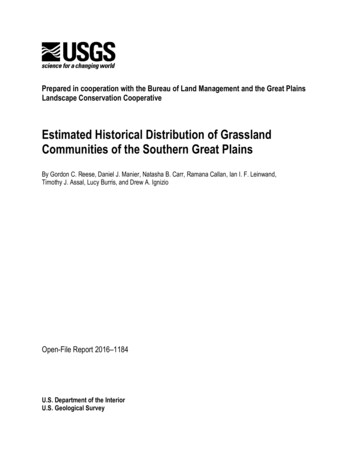
Transcription
Prepared in cooperation with the Bureau of Land Management and the Great PlainsLandscape Conservation CooperativeEstimated Historical Distribution of GrasslandCommunities of the Southern Great PlainsBy Gordon C. Reese, Daniel J. Manier, Natasha B. Carr, Ramana Callan, Ian I. F. Leinwand,Timothy J. Assal, Lucy Burris, and Drew A. IgnizioOpen-File Report 2016–1184U.S. Department of the InteriorU.S. Geological Survey
U.S. Department of the InteriorSALLY JEWELL, SecretaryU.S. Geological SurveySuzette M. Kimball, DirectorU.S. Geological Survey, Reston, Virginia: 2016For more information on the USGS—the Federal source for science about the Earth,its natural and living resources, natural hazards, and the environment—visithttp://www.usgs.gov/ or call 1–888–ASK–USGS (1–888–275–8747).For an overview of USGS information products, including maps, imagery, and publications,visit http://store.usgs.gov/.Any use of trade, firm, or product names is for descriptive purposes only and does not implyendorsement by the U.S. Government.Although this information product, for the most part, is in the public domain, it also maycontain copyrighted materials as noted in the text. Permission to reproduce copyrighted itemsmust be secured from the copyright owner.Suggested citation:Reese, G.C., Manier, D.J., Carr, N.B., Callan, Ramana, Leinwand, I.I.F., Assal, T.J., Burris, Lucy, andIgnizio, D.A., 2016, Estimated historical distribution of grassland communities of the Southern GreatPlains: U.S. Geological Survey Open-File Report 2016–1184, 13 p.,https://doi.org/10.3133/ofr20161184.ISSN 2331-1258 (online)ii
ContentsScientific Names for Species Mentioned in This Report .ivAcknowledgments. vAbstract . 1Purpose and Scope . 1Methods . 4Products . 11Disclaimers . 11Summary . 12References Cited . 12Figures1.2.Map of the Southern Great Plains Rapid Ecoregional Assessment project area . 3Map showing the estimated historical distribution of grassland and adjacent communities inthe Southern Great Plains Rapid Ecoregional Assessment project area . 8Tables1.2.3.Dominant indicator species used to classify grassland communities . 5Attributes for the estimated historical grassland communities dataset. 6Community types for the estimated historical grasslands dataset and correspondingLANDFIRE Biophysical Settings names . 8Conversion FactorsU.S. customary units to International System of UnitsMultiplyBy lengthTo obtainfoot (ft)0.3048meter (m)yard (yd)0.9144meter (m)DatumVertical coordinate information is referenced to the North American Datum of 1983 (NAD 83).Horizontal coordinate information is referenced to the North American Datum of 1983 (NAD 83).iii
RCSREASSURGOUSGSBureau of Land ManagementBiophysical SettingsEcological Site DescriptionsEcological Site InventoryEcological Site Information SystemExisting Vegetation TypeGap Analysis ProjectGreat Plains Landscape Conservation CooperativeLandscape Fire and Resource Management Planning ToolsNatural Resources Conservation ServiceRapid Ecoregional AssessmentSoil Survey Geographic DatabaseU.S. Geological SurveyScientific Names for Species Mentioned in This ReportCommon NameAlkali cordgrassAlkali sacatonArizona cottontopArizona fescueBig bluestemBlack gramaBlue gramaBluebunch wheatgrassBuffalograssCane bluestemGreen needlegrassGypsum gramaIdaho fescueIndiangrassInland saltgrassLittle bluestemMountain bromeMountain muhlyNeedle and threadPrairie sandreedSand bluestemSand sagebrushSand dropseedShinnery oakSideoats gramaScientific NameSpartina gracilisSporobolus airoidesDigitaria californicaFestuca arizonicaAndropogon gerardiiBouteloua eriopodaBouteloua gracilisPseudoroegneria spicata spicataBouteloua dactyloidesBothriochloa barbinodisNassella viridulaBouteloua brevisetaFestuca idahoensisSorghastrum nutansDistichlis spicataSchizachyrium scopariumBromus marginatusMuhlenbergia montanaHesperostipa comataCalamovilfa longifoliaAndropogon halliiAretemesia filifoliaSporobolus cryptandrusQuercus havardiiBouteloua curtipendulaiv
Scientific Names for Species Mentioned in This Report—ContinuedCommon NameSilver beardgrassStreambank wheatgrassSwitchgrassThreadleaf sedgeTobosagrassVine mesquiteWestern wheatgrassScientific NameBothriochloa laguroides torreyanaElymus lanceolatus lanceolatusPanicum virgatumCarex filifoliaPleuraphis muticaPanicum obtusumPascopyrum smithiiAcknowledgmentsThe impetus and oversight for this project were provided by the Southern Great Plains Rapid EcoregionalAssessment advisors and technical experts including Steve Tryon, David Wood, Melanie Barnes, Janine Book, andLaurence Levesque of the Bureau of Land Management, and Nicole Athearn of the Great Plains LandscapeConservation Cooperative. We greatly appreciate technical reviews of the general approach or the estimatedhistorical grassland map provided by Robert Means and George Soehn of the Bureau of Land Management; LeeElliot, Missouri Resource Assessment Partnership; Rick Schneider, Nebraska Natural Heritage Program; EstebanMuldavin, New Mexico Natural Heritage Program; Duane German, Texas Parks and Wildlife Department; JoeStevens, Joanna Lemly, Karin Decker, and Michael Menefee, Colorado Natural Heritage Program; Patrick J.Comer, NatureServe; Steven Rolfsmeier, Chadron State College; Russell Martin, Texas Parks and Wildlife; RussHorton, Oklahoma Department of Wildlife Conservation; and Kelly Kindscher, Kansas Biological Survey. TammyFancher, Patrick Anderson, and Colin Talbert of the U.S. Geological Survey provided reviews of this report, thedata release, and the associated metadata.v
Estimated Historical Distribution of GrasslandCommunities of the Southern Great PlainsBy Gordon C. Reese, 1 Daniel J. Manier,1 Natasha B. Carr,1 Ramana Callan,2 Ian I. F. Leinwand, 2Timothy J. Assal,1 Lucy Burris,1 and Drew A. Ignizio1AbstractThe purpose of this project was to map the estimated distribution of grassland communities ofthe Southern Great Plains prior to Euro-American settlement. The Southern Great Plains RapidEcoregional Assessment (REA), under the direction of the Bureau of Land Management and the GreatPlains Landscape Conservation Cooperative, includes four ecoregions: the High Plains, Central GreatPlains, Southwestern Tablelands, and the Nebraska Sand Hills. The REA advisors and stakeholdersdetermined that the mapping accuracy of available national land-cover maps was insufficient in manyareas to adequately address management questions for the REA. Based on the recommendation of theREA stakeholders, we estimated the potential historical distribution of 10 grassland communities withinthe Southern Great Plains project area using data on soils, climate, and vegetation from the NaturalResources Conservation Service (NRCS) including the Soil Survey Geographic Database (SSURGO)and Ecological Site Information System (ESIS). The dominant grassland communities of the SouthernGreat Plains addressed as conservation elements for the REA area are shortgrass, mixed-grass, and sandprairies. We also mapped tall-grass, mid-grass, northwest mixed-grass, and cool season bunchgrassprairies, saline and foothill grasslands, and semi-desert grassland and steppe. Grassland communitieswere primarily defined using the annual productivity of dominant species in the ESIS data. Thehistorical grassland community classification was linked to the SSURGO data using vegetation typesassociated with the predominant component of mapped soil units as defined in the ESIS data. Weaugmented NRCS data with Landscape Fire and Resource Management Planning Tools (LANDFIRE)Biophysical Settings classifications 1) where NRCS data were unavailable and 2) where fifth-levelwatersheds intersected the boundary of the High Plains ecoregion in Wyoming. Spatial data representingthe estimated historical distribution of grassland communities of the Southern Great Plains are providedas a 30 x 30-meter gridded surface (raster dataset). This information will help to address the prioritymanagement questions for grassland communities for the Southern Great Plains REA and can be used toinform other regional-level land management decisions.Purpose and ScopeThe Bureau of Land Management (BLM) is implementing a landscape approach thatincorporates multiscale information to assess the condition and trends of ndscape Approach.html). A major component of the BLM12U.S. Geological Survey.Cherokee Nation Technologies.1
landscape approach is the Rapid Ecoregional Assessment (REA) program, which provides informationto facilitate development of broad-scale management strategies across jurisdictional boundaries. TheREAs identify and map priority ecological communities and species for particular ecoregions, determinethe degree of risk from development and other change agents, and provide assessments of ecologicalconditions including conservation and restoration potential. The purpose of this project was to map theestimated distribution of grassland communities of the Southern Great Plains prior to Euro-Americansettlement.The BLM partnered with the Great Plains Landscape Conservation Cooperative (GPLCC) toensure that the results of the Southern Great Plains REA provide information useful for addressingmanagement issues identified by a diverse set of stakeholders representing the REA and GPLCC. TheSouthern Great Plains REA project area includes the full extent of the GPLCC’s area(http://www.greatplainslcc.org/about/), as well as the following Omernik Level III ecoregions(Omernik, 1987): High Plains, Central Great Plains, Southwestern Tablelands, and the Nebraska SandHills (and an adjacent buffer delineated by fifth-level watersheds intersecting the ecoregion boundaries)(fig. 1A). The dominant vegetation communities in these four ecoregions are shortgrass, mixed-grass,and sand prairies, which were identified as priority ecological communities by the Southern Great PlainsREA stakeholders (Assal and others, 2015). A priority management issue for this REA is howdevelopment (including agricultural, energy, transportation, and urban) has fragmented and reducedconnectivity of Great Plains ecological communities (Assal and others, 2015). Our objective was to mapthe estimated distribution of grassland communities of the Southern Great Plains prior to EuroAmerican settlement to address management questions for the REA.Both current and estimated historical land-cover maps were needed to quantify howdevelopment has altered landscape structure. For previous REAs, regional or national land-coverdatasets, such as those from the Gap Analysis Program (GAP) and the Landscape Fire and ResourceManagement Planning Tools (LANDFIRE) program were used to map ecological communities (Bryceand others, 2012; Carr and Melcher, 2015; Comer and others, 2013). Because of the accuracylimitations of existing land-cover datasets and challenges associated with mapping the estimateddistribution of grasslands prior to land-use conversions, REA stakeholders suggested using theEcological Site Information System (ESIS) (National Resources Conservation Service, 2015a) and SoilSurvey Geographic Database (SSURGO) (National Resources Conservation Service, 2015b) to map theestimated historical distribution of native grassland communities across the Southern Great Plains forthe REA.We conducted a preliminary review and analysis of the suitability of using existing land-coverdatasets, including GAP (http://gapanalysis.usgs.gov/) and LANDFIRE (Landscape Fire and ResourceManagement Planning Tools, 2012), to map the priority grassland communities for the REA projectarea. The large size of the project area (spanning eight states) required two GAP regions (northwest andsouthwest); pronounced classification discrepancies along the boundaries precluded the use of the GAPdata for mapping grasslands for the REA. We evaluated two LANDFIRE datasets for use: BiophysicalSettings (BpS), representing the potential natural vegetation prior to Euro-American settlement, andExisting Vegetation Type (EVT) (Rollins, 2009).LANDFIRE was developed to map fuels and typically depicts woody fuels more accurately thanherbaceous fuels in rangelands because of limited field data in rangelands (Reeves and others, 2009).For comparison purposes, we used the Texas Ecological Systems Classification vegetation map,developed by the Missouri Resource Assessment Program (Elliot, 2010), as our reference map in thearea of overlap between the Texas vegetation map and the REA project area because the finer resolution(10 x 10-meter raster dataset) and extensive field data (14,000 survey plots) were assumed to provide a2
Figure 1. Map of the Southern Great Plains Rapid Ecoregional Assessment project area. A, Omernik Level IIIecoregions and the buffer region, which includes fifth-level watersheds intersected by the ecoregion boundariesand covers the full extent of the Great Plains Landscape Conservation Cooperative. B, Spatial coverage of theprimary (National Resources Conservation Service) and supplemental (Landscape Fire and ResourceManagement Planning Tools) data sources used to estimate the historical distribution of grassland and othercommunity types.3
more accurate map than LANDFIRE or NRCS data. Our preliminary analysis indicated that NRCSderived classifications, which combine information from both ESIS and SSURGO, generally had thebest correspondence with the Texas Ecological Systems Classification, compared to LANDFIRE EVTand BpS, supporting the REA stakeholders’ recommendation to use NRCS data to map grasslands forthe Southern Great Plains REA. This approach assumes that the combination of substrate and climate iscorrelated with the composition and productivity of prairie vegetation. Understanding of these relationsis in accord with common assumptions that underlie the development and use of Ecological SiteDescriptions (ESDs) and is well established in practice and empirical research (for example, Epstein andothers, 1998).MethodsThe potential distribution (Zerbe, 1998) of grass-dominated ecological communities in theSouthern Great Plains was estimated using soil composition, annual precipitation, and vegetation plotdata developed by the NRCS. SSURGO contains soil information delineated by map units and we usedthe dominant soils component, as represented by the largest percentage, for any map unit with multiplesoil components to map the distribution of soil types.Plant communities for each SSURGO map unit were identified using the ESIS(https://esis.sc.egov.usda.gov). Ecological sites are characterized by soil and physical characteristics,associated plant communities, vegetation productivity, and the potential for a given community torespond similarly to management actions and natural disturbances. The ESIS includes the EcologicalSite Inventory (ESI) database and ESDs. The ESI provides plot-level survey data on soils and plantspecies productivity for each ecological site. The ESDs are peer reviewed reports that includesummarized plot-level survey data and synthesize information on physical factors (soils, temperature,precipitation, hydrology, geology, physiographic features), biotic features (plant species occurrence,plant community composition, plant production), and ecological dynamics (disturbance regimes such asgrazing, fire, drought). To associate each spatial map unit with the appropriate ecological site, the SoilComponent and Ecoclass tables in SSURGO were used.We classified the composition of sites for the project area into 10 grassland community types(shortgrass, mixed-grass, sand, tall-grass, mid-grass, northwest mixed-grass, and cool seasonbunchgrass prairies; semi-desert grassland and steppe; and saline and foothill grasslands; table 1). Ourclassification considered the naming conventions established by the National Vegetation Classification(Nelson and others, 2015) and used the same terminology when applicable. However, to supportrequests from managers and planners, we developed a classification falling between Group andAssociation levels of the National Vegetation Classification hierarchy similar to types considered inhabitat conservation and management. Only shortgrass, mixed-grass, and sand prairies are widelydistributed throughout the four ecoregions in the project area; the remaining seven grassland typesprimarily occur along the periphery of the ecoregions and in the buffer region. Although the lesscommon grassland types were not a focus of our classification, they were included for completeness andcontext relative to adjacent areas.To classify each ecological site, we used the three dominant species, as indicated byaboveground annual productivity (table 1). We followed species naming conventions established by theU.S. Department of Agriculture (Natural Resources Conservation Service, 2015c). Field estimates ofspecies productivity from ESI vegetation plots within ecological sites without ESDs were averaged byspecies and normalized by calculating the percent of total annual yield in each ecological site.Ecological sites with mesic soils or wetland plants were classified as aquatic communities and sitesdominated by woody species were classified as shrubland, woodland, and forest. LANDFIRE BpS4
(Landscape Fire and Resource Management Planning Tools, 2012) was used to classify areas withinsufficient NRCS data and areas within the Southern Great Plains buffer region (fig. 1B), accountingfor approximately 4 percent of the project area.Table 1.Dominant indicator species used to classify ecological sites into grassland communities.Community typeDominant indicator speciesShortgrass prairieBlue grama, buffalograss, western wheatgrassMixed-grass prairieBig bluestem, blue grama, little bluestem, sideoats gramaSand prairiePrairie sandreed, sand bluestem, sand dropseed, sand sagebrush, shinnery oakTall-grass prairieBig bluestem, Indiangrass, little bluestem, switchgrassMid-grass prairieArizona cottontop, cane bluestem, sideoats grama, silver beardgrass, vine mesquiteNorthwest mixed-grass prairieBluebunch wheatgrass, green needlegrass, Idaho fescue, streambank wheatgrassCool season bunchgrass prairieBlue grama, needle and thread, threadleaf sedge, western wheatgrassSemi-desert grassland and steppeBlack grama, gypsum grama, tobosagrassSaline grasslandAlkali cordgrass, alkali sacaton, inland saltgrassFoothill grasslandArizona fescue, mountain brome, mountain muhlyInitial mapping of grassland communities using SSURGO and the associated ESIS revealed gapsand inconsistencies resulting from missing data and inaccurate classification boundaries along countyand state lines. Map units lacking associated ESDs or ESI data were classified using vegetationdescribed for nearby ecological sites with similar soil properties. Map units with classificationinconsistencies along political boundaries (county or state lines) were assigned to the same communityclass as an adjacent ecological site with similar soil properties. In a small portion of the project area,nearby sites with similar soil properties were lacking; in these cases, we used LANDFIRE BpS toaddress the data gap (fig. 1B). The source of information used to classify map units is documented in the“Dataset source” attribute (table 2).The estimated historical distribution map delineates 10 grassland communities (fig. 2). Toprovide a complete coverage of other communities in the project area, we also used NRCS andLANDFIRE BpS to map the estimated historical distribution of shrublands, woodlands, and forests;riparian areas and wetlands; open water; and sparsely vegetated land-cover classes. Because our purposewas to classify and map the historical distribution of grasslands, the woody and aquatic communitieswere grouped into general community types. To identify potential wetland and riparian areas, NRCSdata were used to identify the presence of mesic soils and hydrophilic plant species; identification ofpotential shrublands, savanna, and open woodlands used the presence of indicator grasses and shrubs,and tree species (oak, juniper, or pine) with 10 to 25 percent cover. In areas where LANDFIRE BpS wasused as the data source for classifying woody vegetation, we combined all vegetation types using theBpS names corresponding to shrublands, woodlands, and forests (table 3). We reclassified several BpStypes corresponding to desert scrub types as saline grasslands because those scrub types are uncommonwithin the project area and generally occurred in proximity to areas classified as saline grasslands usingNRCS data (table 3), supporting the reclassification.The attribute names in the dataset are listed and defined in table 2 (Callan and others, 2016). Theattributes include those derived by the U.S. Geological Survey (USGS) and attributes from theSSURGO data that were used in determining land-cover classification. The associated metadataincludes expanded attribute definitions summarized in table 2 (Callan and others, 2016).5
Table 2. Attributes (names and abbreviations), definitions, and originator of the attribute field for the estimatedhistorical distribution of grassland communities dataset. Attribute abbreviations are used in the dataset attributetable and defined in the metadata (Callan and others, 2016).[NRCS, Natural Resources Conservation Service]AttributeoriginatorU.S. GeologicalSurveyNatural ResourcesConservationService1AttributenameObject IdentifierAttributeabbreviationOIDFeature ValueValueGrid cells linked by a feature will have identicalvaluesCountCountCount of grid cells for the Feature ValueVegetation ClassClassAssigned vegetation community classVegetation Class CodeClassCodeNumerical representation of the Vegetation ClassDataset sourceDataSourceSource of the data used to identify and classify theVegetation ClassType of informationInfo TypeType of information used to classify the VegetationClassAdditional details ondata usedDataDetailAdditional details on the data used to classify theVegetation ClassLookup KeyLookupKeyEcological Site Description ID, map unit key, orNRCS classification used to identify theVegetation Class; this is the spatial unit to which aVegetation Class is assignedMap Unit KeyMukeyMap Unit Key is the unique identifier from theNRCS soil component tableComponent KeyCokeyComponent PercentageComppct rComponent Key is a string of characters used touniquely identify a record from the NRCScomponent tablePercentage of the soil component of the map unitfrom the NRCS component tableComponent NameCompnameName assigned to a NRCS soil component based onthe soil propertiesGeomorphic DescriptionGeomdescA narrative description of the geomorphic setting ofthe soil componentTaxonomic Class NameTaxclnameEcological ClassificationIdentifierEcoclassidThe taxonomic class from the NRCS componenttable; the name is a concatenation of the soiltaxonomy subgroup and family for a given soilIdentifier of a particular ecological community fromthe NRCS coecoclass tableEcological ClassificationNameEcoclassnaDefinitionUnique identifier for each row in the attribute tableDescriptive name of a particular ecologicalcommunity from the NRCS coecoclass table1Soil Survey Geographic Database (SSURGO).6
Figure 2. Map showing the estimated historical distribution of grassland and adjacent communities in theSouthern Great Plains Rapid Ecoregional Assessment project area, which includes the Great Plains LandscapeConservation Cooperative area. For illustration, several minor grassland communities are combined and sparselyvegetated areas are not displayed due to their small size, but are retained in the dataset.7
Table 3. Community types for the estimated historical distribution of grasslands dataset and correspondingLANDFIRE Biophysical Settings names.[LANDFIRE, Landscape Fire and Resource Management Planning Tools]Community typeBiophysical Settings nameLANDFIRECodeCool season bunchgrass prairie1 Not applicableFoothill grasslandNorthern Rocky Mountain Lower Montane–Foothill–Valley Grassland11390Northern Rocky Mountain Subalpine–Upper Montane Grassland11400Rocky Mountain Subalpine–Montane Mesic Meadow11450Southern Rocky Mountain Montane–Subalpine Grassland11460Western Great Plains Foothill and Piedmont Grassland11470Mixed-grass prairieCentral Mixedgrass Prairie11320Northwest mixed-grass prairieNorthwestern Great Plains Mixedgrass Prairie11410Chihuahuan Mixed Salt Desert Scrub10750Inter-Mountain Basins Mixed Salt Desert Scrub10810Inter-Mountain Basins Mixed Salt Desert Scrub—South10811Inter-Mountain Basins Mixed Salt Desert Scrub—North10812Chihuahuan Stabilized Coppice Dune and Sand Flat Scrub10760Western Great Plains Sandhill Steppe10940Western Great Plains Sand Prairie11480Chihuahuan Sandy Plains Semi-Desert Grassland11330Chihuahuan Grama Grass–Creosote Steppe11003Apacherian-Chihuahuan Semi-Desert Grassland and Steppe11210Chihuahuan Gypsophilous Grassland and Steppe11220Inter-Mountain Basins Semi-Desert Grassland11350Chihuahuan Loamy Plains Desert Grassland15030Shortgrass PrairieWestern Great Plains Shortgrass Prairie11490Tall-grass PrairieWestern Great Plains Tallgrass Prairie11500Central Tallgrass Prairie14210Southern Blackland Tallgrass Prairie14220Southeastern Great Plains Tallgrass Prairie14230Rocky Mountain Aspen Forest and Woodland10110Western Great Plains Dry Bur Oak Forest and Woodland10130Colorado Plateau Pinyon-Juniper Woodland10160Madrean Encinal10230Madrean Lower Montane Pine-Oak Forest and Woodland10240Madrean Pinyon-Juniper Woodland10250Northwestern Great Plains Highland White Spruce Woodland10480Rocky Mountain Foothill Limber Pine-Juniper Woodland10490Rocky Mountain Lodgepole Pine Forest10500Saline grassland2Sand prairieSemi-desert grassland andsteppeShrubland, woodland, andforest8
Table 3. Community types for the estimated historical distribution of grasslands dataset and correspondingLANDFIRE Biophysical Settings names.—Continued[LANDFIRE, Landscape Fire and Resource Management Planning Tools]Community typeShrubland, woodland, andforest—ContinuedBiophysical Settings nameSouthern Rocky Mountain Dry-Mesic Montane Mixed Conifer Forest andWoodlandSouthern Rocky Mountain Mesic Montane Mixed Conifer Forest and WoodlandLANDFIRECode1051010520Southern Rocky Mountain Ponderosa Pine Woodland10540Southern Rocky Mountain Ponderosa Pine Woodland—South10541Southern Rocky Mountain Ponderosa Pine Woodland—North10542Rocky Mountain Subalpine Dry-Mesic Spruce-Fir Forest and Woodland10550Rocky Mountain Subalpine Mesic-Wet Spruce-Fir Forest and Woodland10560Rocky Mountain Subalpine-Montane Limber-Bristlecone Pine Woodland10570Southern Rocky Mountain Pinyon-Juniper Woodland10590Inter-Mountain Basins Aspen-Mixed Conifer Forest and Woodland10610Inter-Mountain Basins Aspen-Mixed Conifer Forest and Woodland—LowElevationInter-Mountain Basins Curl-leaf Mountain Mahogany Woodland and Shrubland10611Colorado Plateau Mixed Low Sagebrush Shrubland10640Inter-Mountain Basins Mat Saltbush Shrubland10660Rocky Mountain Alpine Dwarf-Shrubland10700Wyoming Basins Dwarf Sagebrush Shrubland and Steppe10720Chihuahuan Creosotebush Desert Scrub10740Chihuahuan Succulent Desert Scrub10770Inter-Mountain Basins Big Sagebrush Shrubland10800Inter-Mountain Basins Big Sagebrush Shrubland—Basin Big Sagebrush10801Inter-Mountain Basins Big Sagebrush Shrubland—Wyoming Big Sagebrush10802Mojave Mid-Elevation Mixed Desert Scrub10820Northwestern Great Plains Shrubland10850Rocky Mountain Lower Montane-Foothill Shrubland10860Rocky Mountain Lower Montane-Foothill Shrubland—No True MountainMahoganyRocky Mountain Lower Montane-Foothill Shrubland—True MountainMahoganySouthern Colorado Plateau Sand Shrubland10861Apacherian-Chihuahuan Mesquite Upland Scrub10950Chihuahuan Mixed Desert and Thorn Scrub11000Chihuahuan Mixed Desert Shrubland11002Madrean Oriental Chaparral11010Colorado Plateau Pinyon-Juniper Shrubland11020Mogollon Chaparral110409106201086210930
Table 3. Community types for the estimated historical distribution of grasslands dataset and correspondingLANDFIRE Biophysical Settings names.—Continued[LANDFIRE, Landscape Fire and Resource Management Planning Tools]Community typeShrubland, woodland, andforest—ContinuedBiophysical Settings nameRocky Mountain Gambel Oak-Mixed Montane ShrublandLANDFIRECode11070Sonora-Mojave Semi-Desert Chaparral11080Western Great Plains Mesquite Woodland and Shrubland11110Inter-Mountain Basins Juniper Savanna11150Madrean Juniper Savanna11160Southern Rocky Mountain Ponderosa Pine Savanna11170Southern Ro
the degree of risk from development and other change agents, and provide assessments of ecological conditions including conservation and restoration potential. The purpose of this project was to map the estimated distribution of grassland communities of the Southern Great Plains prior to Euro-American settlement.
